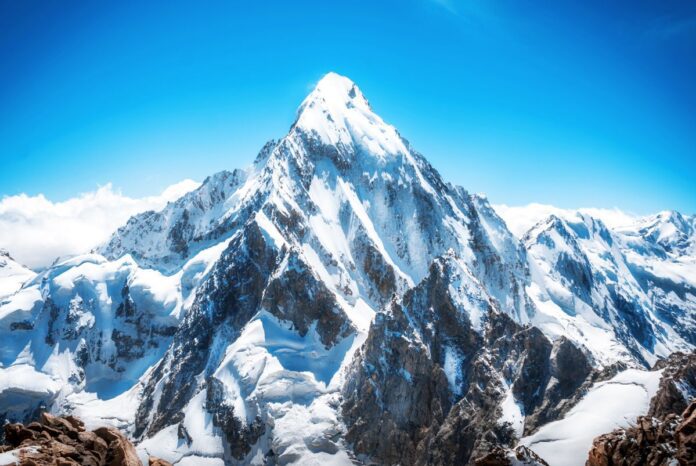Towering high above the Himalayas at 29,032 feet (8,849 meters), Mount Everest has long been hailed as Earth’s loftiest mountain. But is it truly the tallest? As precisely determining the tallest mountain proves complex, the answer intriguingly reveals as much about humanity’s changing perspectives as it does about global topography.
Content Highlights:
- By elevation above sea level, Everest undisputedly tops all peaks by over 1,000 feet (300 meters).
- Measuring from base to peak, the Hawaiian and Andean mountains technically best Everest’s height.
- As the highest point humans can climb, Everest retains cultural significance despite vertical challengers.
- Everest has shrunk over 1 meter from melting, fueling climate concerns, though it is uncertain if it has surrendered its height record.
How Peak Height is Measured
The quest to crown the world’s tallest mountain rests on the challenge of accurately defining and quantifying “height.” Over history, scientists and explorers have employed various measurements, yielding different champions.
Peak Elevation
The elevation benchmark measures a mountain’s height from sea level to its highest point. By this metric, Mount Everest tops all peaks globally by over 1,000 feet (300 meters). However, elevation alone fails to capture absolute height.
Prominence
Prominence indicates how far a mountain rises compared to the surrounding terrain. While a helpful indicator, prominence still doesn’t convey total height.
Peak-to-Peak Height
Arguably the truest assessment is peak-to-base height—the distance from a mountain’s highest point to its base. But definitively identifying the base across massive ranges proves incredibly difficult, opening debates.
Is Mount Everest losing its title to other measurements?
By peak-to-peak standards, towering rivals across Hawaii and Ecuador show Mount Everest isn’t Earth’s tallest after all.
The Hawaii Giant, Mauna Kea
Beneath the Pacific, the Hawaiian volcano Mauna Kea holds a legitimate claim to being the world’s tallest. Although its summit only reaches 13,803 feet (4,207 meters) above sea level, Mauna Kea’s base rests deep on the ocean floor. From peak to base, it measures 33,500 feet (10,210 meters), besting Mount Everest by over 4,500 feet (1,370 meters).
The Andes Challenger, Chimborazo
Similarly, Ecuador’s Chimborazo volcano has a comparable claim, with its summit soaring to 20,564 feet (6,268 meters) in elevation. Yet its base sprawls incredibly low, yielding a peak-to-base height surpassing Everest as well.
Why doesn’t height alone determine the tallest?
If topping out by peak-to-base metrics, why doesn’t Mauna Kea or Chimborazo take the crown? As conversations continue, added context around physically reaching the summit helps explain Mount Everest’s endurance as Earth’s highest point.
Climbing Challenges
Despite lower summits, extremely remote bases make Chimborazo and Mauna Kea nearly impossible to scale from bottom to top. Mount Everest remains the highest point realistically reachable by climbers.
Societal Significance
As the tallest peak humans can stand atop, Mount Everest holds cultural and historical meaning unmatched by solely vertical champions. Its height record inspires awe, risk, and celebration worldwide.
Accessibility
Finally, with base camps within reach, Mount Everest’s summit provides more tangible proof of reaching the apex of Earth’s heights. Whereas remote Hawaiian and Andean bases float conceptually out of grasp,.
Does Everest’s melting glaciers threaten its title?
Climate change impacts add another wrinkle to assessing the legitimate “tallest” as Everest’s shrinking glaciers reshape its height over time. Researchers indicate Everest has shrunk over one meter from ice loss during the past decade alone. Projecting years ahead, it’s possible the world’s rooftops may technically decrease enough to surrender the top spot in certain measurements.
However, massive uncertainty around precisely defining the base elevations of Chimborazo and Mauna Kea introduces questions about whether melting alone would be enough for a dethronement. Regardless of ranking, the visualization of Everest physically shrinking sparks tangible concern over climate change shrinking the world’s perceived height record holder.
Frequently Asked Questions
What are the different ways to measure a mountain’s height?
Mountains can be measured by elevation from sea level to summit, prominence indicating how much they tower over surrounding terrain, or peak-to-base height from the mountain’s highest point to its base. Peak-to-base is considered the truest assessment but also the most difficult.
What measurements make Mauna Kea and Chimborazo taller than Everest?
Hawaii’s Mauna Kea and Ecuador’s Chimborazo have lower summits than Everest’s 29,032 feet (8,849 meters). However, the incredibly deep bases of these volcanoes resting on the ocean floor yield peak-to-base heights exceeding Everest’s, with Mauna Kea towering over 33,500 feet (10,210 meters) tall and Chimborazo surpassing Everest as well from base to summit.
Why is Mount Everest still considered the tallest despite lower peak-to-base heights?
Although losers by some vertical metrics, Mount Everest retains its crown as Earth’s highest point because its summit remains the loftiest reachable by climbers. Everest also holds historical meaning as the apex of height that other solely vertical champions lack.
Is Mount Everest at risk of losing its official title due to climate change impacts?
Ongoing melting of Everest’s glaciers has already lowered its stature, fueling questions about whether it’ll shrink enough to surrender world height records. However, uncertainty around precisely defining the bases of Chimborazo and Mauna Kea introduces doubt if loss from ice melt alone would cause a dethronement.
What gives Mount Everest its cultural symbolism as the world’s highest point?
Reaching 29,032 feet (8,849 meters) on a climbable peak gives Mount Everest tangible proof of reaching Earth’s elevation apex unmatched by hidden vertical challengers. Risking lives to stand at Everest’s summit has captivated humanity for generations as the planet’s supreme height.




![How Much is Lil Baby’s Net Worth in 2024 [Latest Info] Lil Baby Net Worth](https://www.wariat.org/wp-content/uploads/2024/03/Lil-Baby-Net-Worth-150x150.jpg)
![Rob Lowe Net Worth Speculation in 2024 [Comparative Analysis] Rob Lowe Net Worth](https://www.wariat.org/wp-content/uploads/2024/03/Rob-Lowe-Net-Worth-150x150.jpg)

